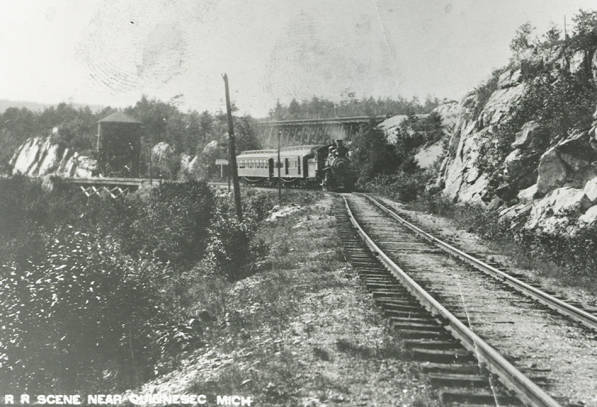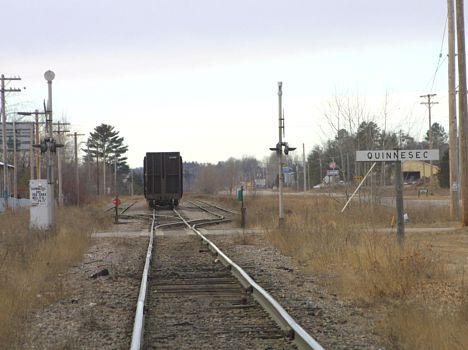- Details
- Hits: 4112
Station: Quinnesec, MI


 Quinnesec was founded in 1871 around the Quinnesec Mine. This village was was originally in Menominee County until Dickenson County was settled in 1871. The town was located on the Chicago & North Western railroad, but also had rail service from the W&M and possibly the Milwaukee Road.
Quinnesec was founded in 1871 around the Quinnesec Mine. This village was was originally in Menominee County until Dickenson County was settled in 1871. The town was located on the Chicago & North Western railroad, but also had rail service from the W&M and possibly the Milwaukee Road.
In addition to its mining history, Quinnesec had a small yard for cars going to and from Niagara, WI via a short branch which crossed the Menominee River. This included forest products and coal inbound and paper products outbound. [CNWPD2]
Photo info: Top, a Wisconsin & Michigan train heads east over Fumee Falls in 1911. [Dickenson Co Library collection]. 2nd photo, the Quinnesec depot about 1910. 3rd photo, the former C&NW small yard at Quinnesec. The CN and E&LS interchange at Iron Mountain about two miles west of this location. 2003. [Dale Berry]
Notes
Today, Quinnesec is home to the Verso paper plant, which is served by the CN railroad and one of the largest employers in the central upper peninsula.
The W&M had a water tower at Quinnesec, using water from Fumee Creek. (See the water tower in the first photo in 1911). The tank foundations are visible from US-2 at the roadside park at Fumee Falls. [GB]
The C&NW depot here was of a bay window design and was located at Quinnesec Street.
The Cundy Mile was located just north of the C&NW main line west of Bluff Street.
The Quinnesec mine was located north of town. The track from the C&NW was removed by 1917. [CNWV]
The C&NW had a long siding here, which allowed servicing the mines without affecting the main track. It was about 1.5 miles long.
Time Line
1871. Quinnesec settled as a mining town.
1897. The Northwestern Railroad company Thursday moved one of its dwellings from the vicinity of the Emergency Hospital in Iron Mountain to Quinnesec, where it will be utilized as a dwelling for one of the company's employees. The structure was loaded on two flat cars and considerable difficulty was experienced in running the train with its unique load of freight. The line men were obliged to cut a number of wires to allow the train to pass beneath the overhanging strands stretching across the tracks. [RTR-1897-0417]
1901.The fact that the contract has been let for the extension of the C.M. & St. P. railroad from Iron Mountain to Quinnesec has caused quite a flutter in railroad and business circles. Mcintosh Bros, of Milwaukee, have the contract, and it is their purpose to at once begin clearing the right of way of all brush and timber, it being a provision of their contract that all such work is to be completed by the first of March. As soon thereafter as the weather will permit the construction work will be taken up and rushed to completion—the intention being to have regular trains running into Quinnesec by the middle or last of May. [Bessemer Herald, February 2, 1901]
1902. The MILW installs a new water tank and pipe line here at a cost of $600. [MCR-1902] Note: This may have been built on the Quinnesec Branch near the mine or the Vivian Mine. The source is not specific.
1903. We were informed this week by Mr. and Mrs. Thomas McKenna, of Quinnesec, that they had sold to the Wisconsin & Michigan Ry., the right-of-way through their land near Quinnesec, for a consideration of $2,500. This would seem to insure the entrance into Quinnesec of the railway at no distant date. [IMP-1903-0806]
1903. The W. & M. will run its first passenger train to Quinnesec tomorrow, leaving Norway at 11:20. The depot at that place has been completed and operator Hansen, who has been stationed at Loretto, will be in charge. A number of the officials of the road will make the initial trip. Rail has been laid west of Quinnesec for the distance of one mile. [IMP-1903-1203]
1906. November 1. The Wisconsin & Michigan Railroad company is building a terminal station one mile west of Quinnesec for the purpose of handling the passenger and freight traffic for Iron Mountain. The building is 16x40 and is being built by Contractor Axel Newman, of Norway, who expects to have it completed in about two weeks. When ready for traffic the proposed stage line will be put into commission and an effort will be made to secure some of the Iron Mountain business. Contractor Newman also has the job of building a round-house at Quinnesec which will be located just west of the Cundy mine and a water tank just east of Quinnesec, where the track crosses the creek on the McKenna farm. The road is to be extended to Iron Mountain in the spring, as soon as the frost is out of the ground. [IMP-1906-1101]
Two newspaper accounts of Dickinson County's most disastrous train accident will conclude this brief history of area railroads. In the early morning of October 31, 1906, five men were killed at Quinnesec Junction when a Milwaukee, Chicago and St. Paul freight train and a train carrying miners from the Traders Mine collided head on in a dense fog.
Iron Mountain Press, Iron Mountain, Dickinson County, Michigan, Volume 11, Number 24
[Thursday, November 1, 1906], page 1, columns 3-4
1906. A disastrous fire destroys the entire business district and several homes. Some of the establishments were rebuilt.
1909. June 30. The Wisconsin & Michigan Railway Company opened a line connecting the Cundy Mine in Quinnesec with Iron Mountain on June 30, 1909, forming the northern terminus of this railroad. (This railroad company was abandoned January 13, 1938, although the last train south from Iron Mountain left July 1 of that year.)
1918. The C&NW had an agent and telegraph operator at this station on the day shift. [TRT]
1985. Champion International Corporation builds a large pulp and paper mill east of here, employing 520 people. It is now owned by Verso Paper.
Bibliography
The following sources are utilized in this website. [SOURCE-YEAR-MMDD-PG]:
- [AAB| = All Aboard!, by Willis Dunbar, Eerdmans Publishing, Grand Rapids ©1969.
- [AAN] = Alpena Argus newspaper.
- [AARQJ] = American Association of Railroads Quiz Jr. pamphlet. © 1956
- [AATHA] = Ann Arbor Railroad Technical and Historical Association newsletter "The Double A"
- [AB] = Information provided at Michigan History Conference from Andrew Bailey, Port Huron, MI

